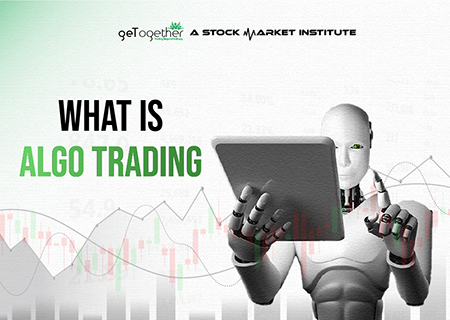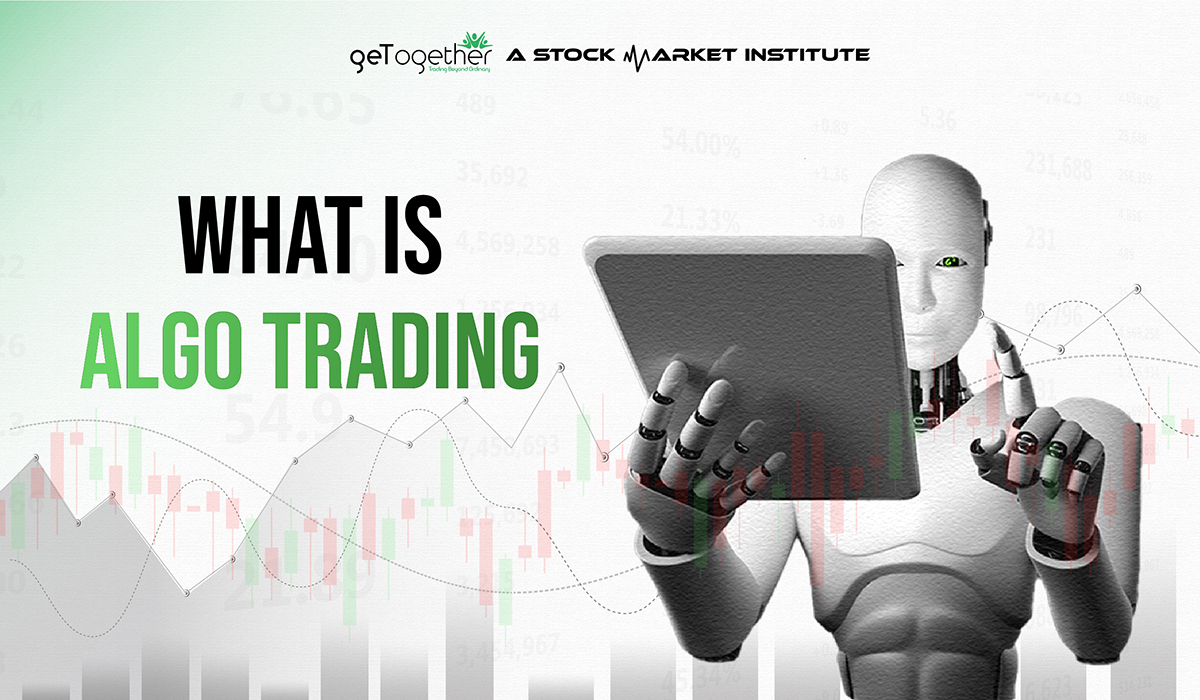What is Algo Trading?


Algo trading, also known as algorithmic trading, is a way to use computer programs to make trades. These projects observe a bunch of guidelines and directions to decide when to trade resources in financial business sectors. Algo trading has become progressively well known as of late, as it permits traders to execute trades rapidly and effectively, while additionally stopping close-to-home inclination from the trading system.
Algo trading is a type of trading strategy in which computer programs use pre-defined rules and conditions to automatically execute trades. It involves making trades based on signals and trends that have been predetermined using sophisticated algorithms that look at market data.
These calculations can be founded on different variables, including specialized pointers, news occasions, and, surprisingly, web-based entertainment opinion. Scalping, swing trading, and trend following are just a few of the trading strategies that can benefit from algo trading.
History of Algo Trading

The starting points of algo trading can be followed back to the 1970s when financial establishments started utilizing PC projects to computerize their trading methodologies. Despite their inferiority to modern algo trading systems, these early programs offered significant advantages over manual trading.
With the rise of high-frequency trading, the widespread use of algo trading began in the late 1990s and early 2000s. Algorithms are used in high-frequency trading to take advantage of minute price swings in the market and place trades in milliseconds. Numerous market participants, including banks, hedge funds, and individual traders, use algorithmic trading today.
Understanding Algorithmic Trading
Algorithmic trading sounds fancy, but it’s putting your trading brain on autopilot. These computer programs, also known as algorithms, follow your pre-set rules to buy and sell equities and shares. Precise timing, price, and math models are Algo’s key ingredients. The goal? To ditch the emotional roller coaster and trade with cool, hard logic.
The roots of algo trading stretch back to the 1970s when financial firms introduced computer programs. These systems were much less advanced than today’s, but these early programs brought significant change in the world of trading. Now these algos work at lightning speed, recording trends swiftly and spotting price gaps like finance police.
Whether it is navigating market trends, getting quick wins, or maintaining balanced investment baskets, there’s an algo for every need. The whole concept of algo is to save investors from more second-guessing or late-night market anxiety. But remember- like every other computer program, this robot trader also needs a human touch. Test your algo on historical data, set up safety measures, and vigilant market monitoring to save yourself from significant losses.
How Algo Trading Works?

Algo trading works by looking at data from the market and making trades based on rules and conditions that have been set in advance. These rules can be based on technical indicators, charts, and observing candlesticks, among other things.
The algorithm executes the trade automatically, frequently without human intervention, when a trading signal is generated. This permits merchants to make the most of market open doors progressively, immediately brought about by manual trading.
Algo trading can be utilized for a variety of trading systems, including pattern following, mean inversion, and measurable exchange. It can also be used to trade stocks, options, and futures, among other asset classes.
There are a few kinds of algorithmic trading systems, including:
Strategies for following trends: The goal of these strategies is to track market trends until they change direction.
Methods for mean reversion: These procedures plan to recognize resources that are underestimated or exaggerated compared with their authentic midpoints and trade them appropriately.
Strategies for arbitrage: The goal of these tactics is to take advantage of price differences between various securities or markets.
Strategies for high-frequency trading (HFT): These procedures utilize strong PCs and low-idleness organizations to execute exchanges at high paces, frequently in parts of a second.
Do-It-Yourself : Algorithmic Trading

You can craft your own trading bot in the DIY algo universe! It is a thrilling dance of algorithms, full of learning and potential rewards. What you need is basic knowledge of the coding language.
Gear up for DIY Algo:
- Programming Skills: Python, R, or C++.
- Trading Platform: Select one with API access, like Zerodha Kite Connect.
- Backtesting Software: To simulate your bot’s performance with historical data.
Select trading strategies and guidelines, translate your strategy into code, and experiment for a while (without investing). To make sure your algo won’t go behind your back, monitor your program closely and adapt when needed. Go live cautiously and start your own algo trading. In the beginning, invest with a small fund, monitor your bot closely to find the areas of improvement and keep updating.
Remember, the market’s a dance – your logic leads, your bot’s speed follows.

Advantages of Algo Trading
Algorithm trading has a number of advantages over manual trading, including the following:
Speed:
Algo trading can execute trades in milliseconds, permitting traders to make the most of the market’s open doors continuously. High-frequency trading strategies benefit most from this speed advantage because even a minute delay can result in missed opportunities.
Consistency:
Algorithm trading enables objective and consistent decision-making. Algorithm trading systems can be programmed to adhere to particular trading rules and strategies, removing human traders’ emotional and psychological biases.
Backtesting:
Algorithm trading systems can be estimated for their performance under various market conditions by backtesting them using historical market data. This enables traders to improve their overall performance and refine their trading strategies.
Scalability:
Algorithm trading can be easily scaled to simultaneously trade multiple markets and assets. This enables traders to diversify their trading portfolios and take advantage of numerous market opportunities at the same time.
Reduced Transaction Costs:
Algorithmic trading can reduce transaction costs by reducing the impact of market frictions. High-frequency trading strategies benefit most from this, as transaction costs can quickly scale up.
Disadvantages of Algo Trading
While algorithm trading has a number of benefits, there are also potential disadvantages to keep in mind, such as:
Complexity For non-technical traders:-
Algo trading systems can be complicated and difficult to understand for traders who are from not technical background. Effective trading strategies can be difficult to develop and implement as a result of this.
Problems with the Technology:-
Algorithm trading systems completely rely on technology, and issues with the Technology, such as system crashes or network failures are common hence it can disrupt trading and cause major losses for traders.
Overreliance on past Data:-
Trading signals generated by algorithmic trading systems are based on historical market data, which may not always accurately reflect current market conditions. If the market behaves differently than anticipated, this could result in unexpected losses for traders.
Lack of Flexibility:-
Because algorithm trading systems are based on specific rules and conditions, their adaptability to shifting market conditions may be restricted. If the market acts differently than expected traders can suffer losses.
Impact of Algo Trading on the stock market
Algorithm trading has had a powerful impact on the stock market. It has contributed to lowering transaction costs and increasing market efficiency by providing liquidity and enhancing price discovery. Simultaneously it has been criticized for increasing market crashes and contributing to market volatility. “Flash crashes” and other market abnormalities have been attributed, in particular, due to algo trading strategies.
Also Read: Securitization
Conclusion
Algo trading is a trading methodology that utilizes progressed calculations and PC projects to execute trades. It has many advantages over traditional manual trading, but there may also be drawbacks to consider. It is essential for traders to comprehend the advantages and disadvantages of algo trading and to devise efficient trading strategies that take these aspects into consideration. Traders can minimize the risks associated with algo trading while still reaping the potential rewards.
FAQs
1. What is Algo Trading?
Algo Trading, short for Algorithmic Trading, is a technique of executing buy or sell orders using pre-programmed instructions on a computer. It entirely depends on algorithms and pre-set guidelines. The system trades after overviewing guidelines, market conditions and automatically executing trades.
2. How does Algorithmic Trading work?
Algorithms process market data, identify trading opportunities, and execute orders at ideal prices. It involves complex mathematical models and strategies to make split-second decisions.
3. What are the advantages of Algo Trading?
Algo trading has many pros and holds the potential future opportunities. The benefits vary from quicker execution, reduced human error, efficient use of market opportunities, to the ability to backtest strategies for improved performance.
4. Are there any risks associated with Algorithmic Trading?
Yes! Since no machine can be 100% ideal, the risks include system glitches, market volatility, and algorithmic errors. The speed of execution can also lead to increased losses, and strategies need careful monitoring.
5. Can individual investors participate in Algo Trading?
Yes, with the rise of online platforms, individual investors can access algo trading. Many brokers offer algorithmic trading services to retail investors.
6. What are some common algorithms used in Algo Trading?
Common algorithms include Trend Following, Mean Reversion, Statistical Arbitrage, and Market Making. Each serves a specific purpose in optimizing trading strategies.
7. How does Algo Trading differ from traditional trading methods?
Algo Trading relies on computer programs and mathematical models to make decisions, executing trades at high speeds, while traditional trading involves human decision-making and manual order execution.
8. What role does data play in Algorithmic Trading?
Data is the heart of algo trading. Data of historical price, volume, and market indicators, is crucial. These algorithims use this data to analyze patterns, identify trends, and make informed trading decisions.
9. Are there any regulations governing Algo Trading?
Yes, financial regulatory bodies worldwide impose regulations to make sure fair and orderly markets. Regulations cover areas like risk controls, transparency, and market manipulation prevention.
10. What are the key considerations for implementing an Algo Trading strategy?
Considerations include robust risk management, backtesting strategies, continuous monitoring, adapting to market conditions, and ensuring compliance with regulatory requirements.
11. What are the requirements to become an algorithm trader?
A strong background in finance, mathematics, or computer science is helpful for algo traders. Programming expertise and an understanding of statistical analysis are also necessary. It’s also important to keep up with market trends and learn new things all the time.
12. Can trading algorithms guarantee profits?
No, algo trading doesn’t ensure benefits. While it offers benefits, for example, speed and productivity, economic situations and unanticipated occasions can prompt misfortunes. Its success necessitates thorough research, solid strategies, and efficient risk management.
13. Are strategies for algo trading appropriate for individual retail traders?
Individual retail traders can indeed employ algo trading strategies. However, having a solid comprehension of programming and market dynamics is essential. Retail dealers ought to likewise begin with little capital and completely test their systems prior to sending them into live trading.
14. Is algo trading legitimate?
Indeed, algo trading is lawful in most financial business sectors. However, traders must adhere to the regulations established by regulatory authorities because specific regulations may apply. It is essential to keep up with legal requirements and, if necessary, seek professional advice.
15. How might I begin with algo trading?
To begin with, algo trading, you can start by picking up programming dialects like Python. Find out more about market information examination, specialized pointers, and trading procedures. Think about joining the web networks, going to studios, and using instructive assets to upgrade your insight and abilities.
CATEGORIES



 Facebook
Facebook  Instagram
Instagram  Youtube
Youtube 
